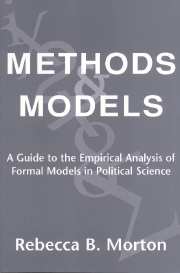9 - The Present and the Future
Published online by Cambridge University Press: 10 December 2009
Summary
In this chapter I recast the foregoing analysis (of example implications) in a set of guidelines for empirical analysis of formal models. But I do not wish to end my exploration with just a simple set of rules. As noted in Chapter1, in political science today there is a gap – between much of the empirical based research and formal modeling – which this book is an attempt to bridge. In Chapter 1 I explored why this gap has developed. I believe that, by bridging the gap, political science could advance to a second revolution in which methods and models work together. In the next section I present my practical side, the guidelines for empirical analysis of formal models. Then I examine the empirical analysis of formal models as part of the big picture, my vision of the future of political science in the second revolution.
Guidelines for the Present
The Process of Empirical Analysis
My hope is that this study of the empirical analysis of formal models will lead to an increased use of formal models in empirical work and vice versa. I have stated that my aim is to provide a framework or blueprint for the empirical analysis of formal models. I present this framework in the form of a series of steps, although the steps analogy does not here imply that the empirical analysis should be undertaken only in this order.
Step 1: Understanding Assumptions. The first step in examining the empirical viability of a formal model is an explicit understanding of the assumptions. The following questions should be asked.
- Type
- Chapter
- Information
- Methods and ModelsA Guide to the Empirical Analysis of Formal Models in Political Science, pp. 279 - 294Publisher: Cambridge University PressPrint publication year: 1999



